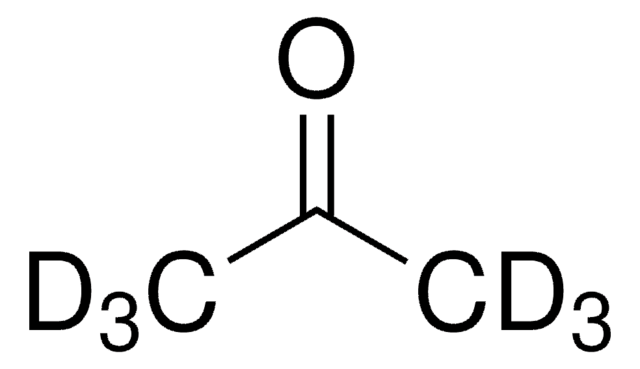494275
Chloroforme-d
"100%", 99.96 atom % D, contains 0.03 % (v/v) TMS
Synonyme(s) :
Deutérochloroforme
About This Item
Produits recommandés
Niveau de qualité
Pureté isotopique
99.96 atom % D
Essai
≥99.00%
Forme
liquid
Contient
0.03 % (v/v) TMS
Technique(s)
NMR: suitable
Impuretés
≤0.0100% water
water
Indice de réfraction
n20/D 1.444 (lit.)
pb
60.9 °C (lit.)
Pf
−64 °C (lit.)
Densité
1.500 g/mL at 25 °C (lit.)
Changement de masse
M+1
Chaîne SMILES
[2H]C(Cl)(Cl)Cl
InChI
1S/CHCl3/c2-1(3)4/h1H/i1D
Clé InChI
HEDRZPFGACZZDS-MICDWDOJSA-N
Vous recherchez des produits similaires ? Visite Guide de comparaison des produits
Description générale
Application
Produits recommandés
À utiliser avec
Mention d'avertissement
Danger
Mentions de danger
Classification des risques
Acute Tox. 3 Inhalation - Acute Tox. 4 Oral - Carc. 2 - Eye Irrit. 2 - Repr. 2 - Skin Irrit. 2 - STOT RE 1 Oral - STOT SE 3
Organes cibles
Central nervous system, Liver,Kidney
Code de la classe de stockage
6.1C - Combustible acute toxic Cat.3 / toxic compounds or compounds which causing chronic effects
Classe de danger pour l'eau (WGK)
WGK 3
Équipement de protection individuelle
Eyeshields, Faceshields, Gloves
Faites votre choix parmi les versions les plus récentes :
Déjà en possession de ce produit ?
Retrouvez la documentation relative aux produits que vous avez récemment achetés dans la Bibliothèque de documents.
Les clients ont également consulté
Notre équipe de scientifiques dispose d'une expérience dans tous les secteurs de la recherche, notamment en sciences de la vie, science des matériaux, synthèse chimique, chromatographie, analyse et dans de nombreux autres domaines..
Contacter notre Service technique





